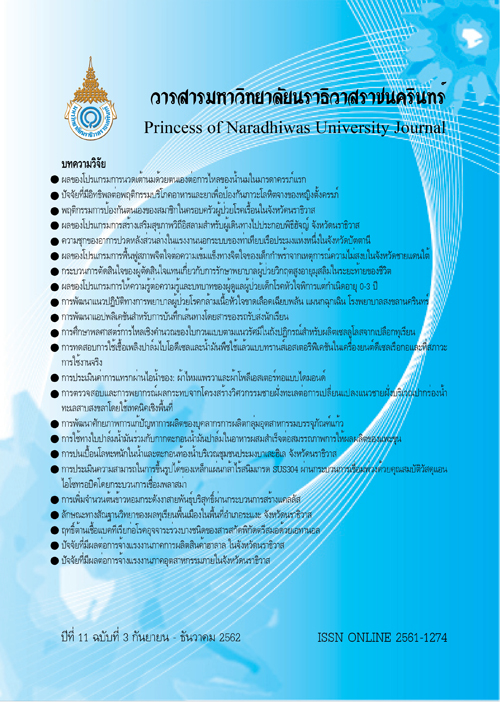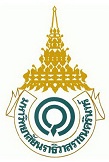ผลของโปรแกรมการนวดเต้านมด้วยตนเองต่อการไหลของน้ำานมในมารดาครรภ์แรก
คำสำคัญ:
การนวดเต้านมด้วยตนเอง, การไหลของน้ำานมมารดาครรภ์แรกบทคัดย่อ
การวิจัยกึ่งทดลองนี้ มีวัตถุประสงค์เพื่อศึกษาผลของโปรแกรมการนวดเต้านมด้วยตนเองต่อการไหลของน้ำานมใน
มารดาครรภ์แรก กลุ่มตัวอย่างเป็นมารดาครรภ์แรกที่มารับบริการฝากครรภ์ คลอด และหลังคลอด ที่โรงพยาบาลชุมชนแห่งหนึ่ง
คัดเลือกกลุ่มตัวอย่างตามคุณลักษณะที่กำาหนด จำานวน 50 ราย แบ่งออกเป็นกลุ่มควบคุมที่ได้รับการพยาบาลตามปกติ 25 ราย
และกลุ่มทดลองที่ได้รับโปรแกรมการนวดเต้านมด้วยตนเอง 25 ราย เครื่องมือการวิจัย ประกอบด้วย (1) เครื่องมือที่ใช้ในการ
ทดลอง ได้แก่ โปรแกรมการนวดเต้านมด้วยตนเอง (2) เครื่องมือที่ใช้ในการเก็บรวบรวมข้อมูล ได้แก่ แบบบันทึกข้อมูลส่วนบุคคล
และแบบบันทึกการประเมินการไหลของน้ำานม และ (3) เครื่องมือที่ใช้ในการกำากับการทดลอง ได้แก่ แบบบันทึกการนวดเต้านม
ด้วยตนเองในระยะหลังคลอด เครื่องมือดังกล่าวได้ผ่านการตรวจสอบความตรงเชิงเนื้อหาโดยผู้ทรงคุณวุฒิ 3 ท่าน ได้ค่าดัชนี
ความตรงด้านเนื้อหา เท่ากับ .80 ทดสอบหาความเที่ยงระหว่างผู้สังเกต ของแบบประเมินการไหลของน้ำานม ได้ค่าเท่ากับ .90
วิเคราะห์ข้อมูลด้วยสถิติความถี่ ร้อยละ ค่าเฉลี่ย ส่วนเบี่ยงเบนมาตรฐาน สถิติไคสแควร์ ทีอิสระ และ Kruskal Wallis Test
ผลการวิจัย พบว่า มารดาครรภ์แรกที่ได้รับโปรแกรมการนวดเต้านมด้วยตนเองมีคะแนนเฉลี่ยการไหลของน้ำานม
หลังการทดลองในชั่วโมงที่ 4, 12, 24, และ 48 สูงกว่ากลุ่มที่ได้รับการพยาบาลตามปกติ อย่างมีนัยสำาคัญทางสถิติ ( = 4.99,
p < .05), ( = 14.05, p < .001), ( = 7.23, p < .01), ( = 20.85, p < .001) ตามลำาดับ จากผลการวิจัยนี้แสดงให้เห็นว่า
โปรแกรมการนวดเต้านมด้วยตนเองมีผลต่อการไหลของน้ำานม พยาบาลจึงควรนำาโปรแกรมการนวดเต้านมด้วยตนเองมาประยุกต์
ใช้เพื่อส่งเสริมการเลี้ยงลูกด้วยนมแม่ในมารดาครรภ์แรก
เอกสารอ้างอิง
Aontrakul, S. (2010). Early problem in breastfeeding. In Woramongkol, N. (editors), Breastfeeding Specialist
Training Manual (2nd ed., pp. 116-44). Bangkok: Veterans Affairs Organization. (in Thai)
Bai, Y., Wunderlich, S. M., & Fly, A. D. (2011). Predicting intentions to countinue exclusive breastfeeding for
6 months: A comparison among racial/ethnic group. Maternal Child Health Journal, 15(8), 1257-64.
Burns, N., & Grove, S. K. (2005). The practice of nursing research: conduct, critique, andutilization. St. Louis, Mo.: Elsevier Saunders.
Cetthkrikul, N., Topothai, C., Topothai, T., Pongutta, S., Kunpeuk, W., Prakongsai, P., &Thammarangsi, T. (2016). Situation of breastfeeding among mothers receiving services in Public Hospitals in Thailand. Journal of Health Science, 25(4), 657-668.
Charoensunti, J. (2011). Assessing the health status of pregnant women and their families. In Charuvatchapanjakul, A. (Editor), Introduction to Midwifery Nursing 1, 273-94.
Danthes, D. (2016). Breastfeeding promotingprogram/ attitude to exclusive breastfeeding/ intention to exclusive breastfeeding/ working pregnant women. A Thesis the Degree of Master of Nursing Science Burapha University, Chonburi.( in Thai)
Hankimnart, P., Akrapride, S., Todsanid, R., & Techakraisri, K. (2011). Successful6month exclusive breastfeeding in postnatal mothers at Siriraj Hospital. Journal of Public Health, 20(5), 766-77.
Hangchovanic,Y.(2012).Promotionofbreastfeedingduringpregnancy.InMuttaram,S.,Shusin,K.,Suthatworavut,U., Saengtaweesin, V., & Chevawan, Y. (editors), Breastfeeding Texts (pp. 99-106) Bangkok: The Breastfeeding Foundation of Thailand. (in Thai)
Janpia, C. (2012). Anatomy of the breast The physiology of the creation and secretion of milk And the sucking mechanism of the baby. In Vijitsukon, K., Sangmuang, P., Yatavoyu, N., Ruangjitsutra, S., & Tayakruang, S. (editors), Breastfeeding (pp. 61-82). Bangkok: Pre-One.(in Thai)
Jongpensukles,Y.(2012).Breast-feedingpracticesinpostnatalcare.InMuttaram,S.,Shusin, ,Suthatworavut,U., Saengtaweesin, V., & Chevawan, Y. (editors), Breastfeeding Texts (page 123-134). Bangkok: The Breastfeeding Foundation of Thailand. (in Thai)
Kala, S. (2018). Breastfeeding support: Nurses’Role. Songkla: Chanmuang Printing. (in Thai)
Kala, S. & Khoonphet, C. (2017). Experience in promoting breastfeeding of registered nurses working in postpartum units. Princess of Naradhiwas University Journal, 9(3), 1-10
Kent, JC., Prime, DK., & Garbin, CP. (2012). Principles for maintaining or increasing breast milk Production.Journal Gynecol Neonatal Nurse, 41(1), 114-121.
Lawrence, R. A., & Lawrence, R. M. (2016). Breastfeeding: A guide for the medical profession (8th ed.). United States of America: Elsevier.
Mamak, N. & Turner, K. (2016). Nurses’ roles and promoting the participation of husbands or relatives for the success of breast feeding. Journal of Nursing, 43(3), 114-126.
Navawong, T., Thongpeng, P., Ambumrung, P., & Thiencharoen, M. (2013). A Comparison of the effect of breast massage on nursing behavior by nursing staff, husband and woman, postpartum self-masturbation on lactation and maternal postpartum stress. The National Breastfeeding Society proceeding book, 4 (p. 118). Bangkok: The Breastfeeding Center of Thailand.(in Thai)
Panngam, N., Theerasopon, P., & Ungpansattawong, S. (2015). The effect of warm moist polymer gel pack comparison on the onset of milk production in primiparous mother. Journal of Pharpokklao Nursing College, 27(1). 28-38.
Payakkaraung, S. (2012). Factors influencing to breastfeeding. In Vijitsukon, K., Sangmee, P., Vatayu, N., Ruangjirustthip, S., & Payakruang, S. (editors), Breastfeeding (pp. 21-42). Bangkok: Pre-One. (in Thai)
Polit, D., & Beck, C.T. (2012). Nursing research: Generating and assessing evidence for nursing practice (9thed.). Philadelphia, PA: Lippincott Williams and Wilkins
Pranpanas, S., Antrakan, S., & Hangchivanic, Y. (2012). Anatomy of the breast and mechanism of formation and secretion of milk. In Muttaram, S., Schusin, K., Suthatworavut, U., Saengtaweesin, V., & Hangchivanic, Y.(editors), Textbooks for Breastfeeding (pp. 1-13). Bangkok: The Breastfeeding Foundation of Thailand. (in Thai)
Sakontarat, P. & Pakdechote, S. (2012). Comparison between hot herbal comparison and warm Comparison in increasing milk production in pospartum mothers, Sakonnakhon Hospital. Journal of Sakon Nakhon Hospital, 15(3), 1-10.
Sawasdiworn, S. (2010). Specificity of breastfeeding and infant health. In Niponporn Woramongkol (Editor),Breastfeeding Specialist Training Manual. (2nd ed, pp. 116-144). Bangkok: Veterans Affairs Organization. (in Thai)
Sriwichai, P., & Suriyachi, P. (2014). The success of the exclusive breastfeeding among teenage mothers in the firfist 6 months after birth at Phayao Hospital. Journal of Nursing, King Chulalongkorn University, 26(1), 17-24.
Tangsuksan, P. (2012). Breastfeeding practices during pregnancy. In Vijitsukon, K., Sangmee, P., Vatayu, N., Ruangjirustthip, S., & Payakruang, S. (editors), Breastfeeding (pp. 129-145). Bangkok: Pre-One. (in Thai)
Trainapakul, C., Chaiyawattana, M., Kanavitoon, W., Tiumtaogerd, R., Naka, S., Mitrniyodom, W., & Panlap, S. (2010). Effect of milk ejection performance of postpartum mother after breasts massage and compression with mini hot bag and herbal compress. Nursing and Education, 3(3), 75-91.
Tucker, C. M., Wilson, E. K., & Samandari, G. (2011). Infant feeding experiences among teen mothers in North Carolina: Finding from a mixed-methods study. International Breastfeeding Journal, 6(1), 14.
UNECEF. (2016). Infant and Yong Child-feeding. Retrieve, form http://data.unicef.org/topic/nutrition/ infant-and-yong-child-feeding/
Wongsiri, A. (2013). Breast massage: a way to add milk. The National Breastfeeding Society proceeding book, 4 (pp. 75-79). Bangkok: The Breastfeeding Center of Thailand. (in Thai)
Wongwan, S. (2013). Massage and breast massage with herbs in postpartum women. The National Breastfeeding Society proceeding book, 4 (pp. 101-04). Bangkok: The Breastfeeding Center of Thailand. (in Thai)




